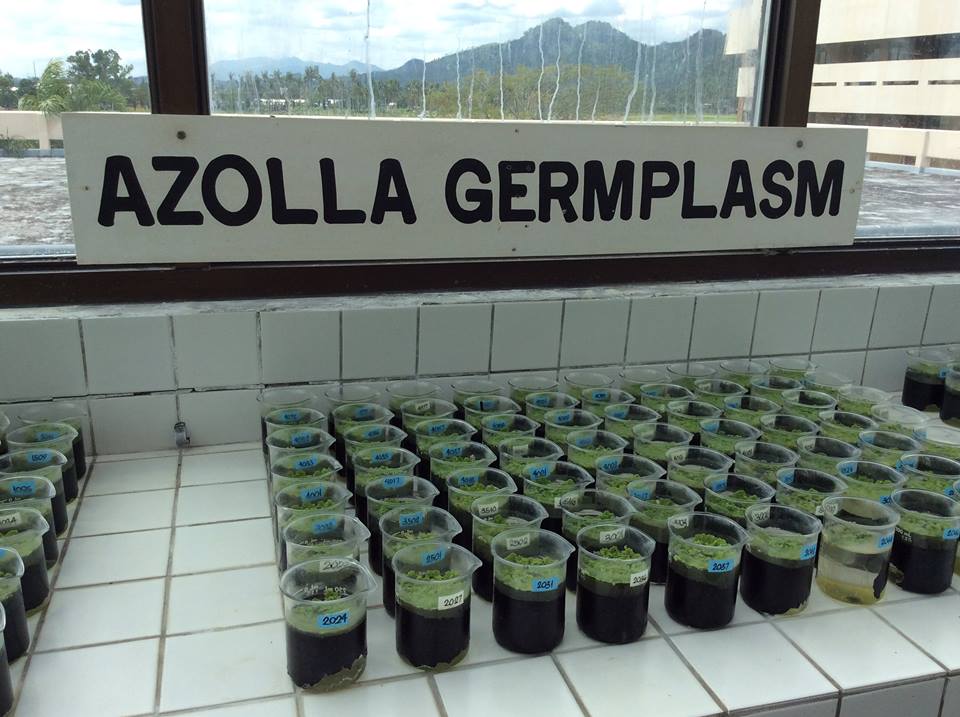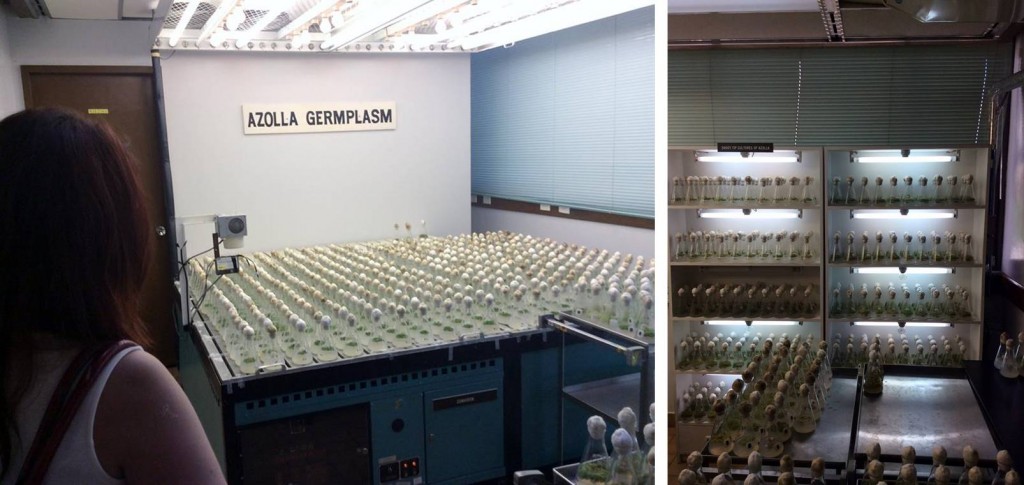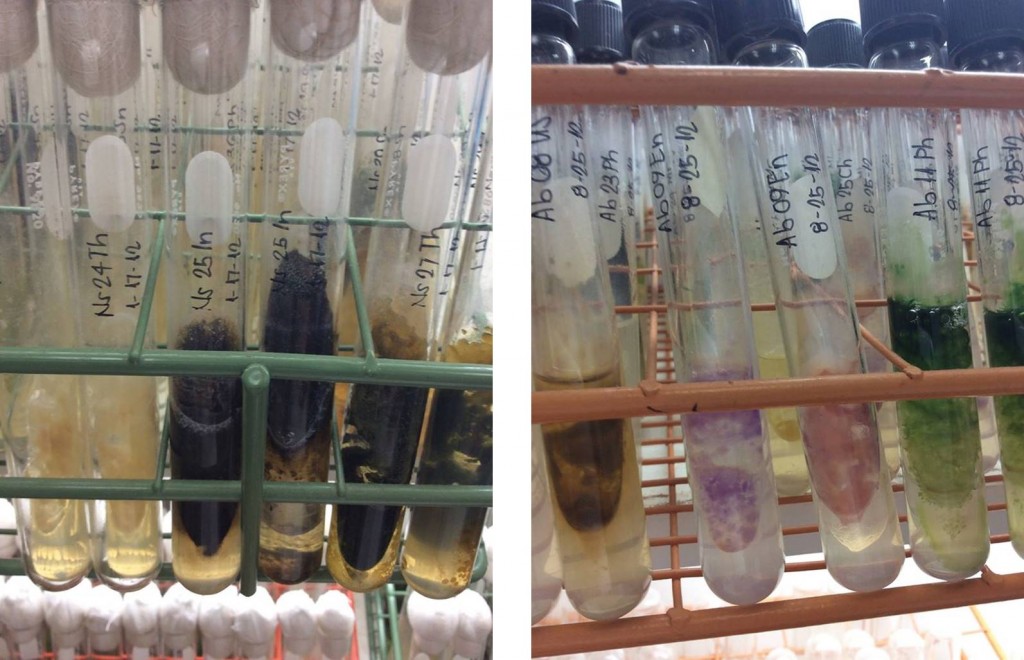The Philippines’ International Rice Research Institute (IRRI) has been undertaking intensive research into rice cultivation since the 1960’s.
IRRI is a nonprofit research and training center established to reduce poverty and hunger, to improve the health of rice farmers and consumers, and ensure environmental sustainability through collaborative research, partnerships, and strengthening of national agricultural research and extension systems.
It has the largest azolla germplasm repository in the world, including 525 hybrids originating from 55 countries.
According to Azolla Foundation Associate, Dr Francisco Carrapiço: “In Europe the germplast collection at the Catholic University of Leuven, Belgium, may have been abandoned after the retirement of Charles Van Hove” and this has been confirmed by Azolla Foundation Associate François Laviolette (personal communication to Jonathan Bujak).
Visit by Alexandra and Jonathan Bujak, March 2015
The following description and photographs are based on a visit in March 2015 by Azolla Foundation co-founders Alexandra and Jonathan Bujak to IRRI and the Philippine Rice Research Institute (PhilRice), which are both located at the University of the Philippines at Los Baños (UPLB).
Everyone was extremely kind and accommodating, and our host at UPLB was Dr Genaro A. Cuaresma, who has worked on azolla for more than 40 years, including his close collaboration with Dr Iwao Watanabe during the 1970s to 1990s.
Drs Cuaresma and Watanabe developed IRRI’s germplasm collection in the 1970s to 1990s when they greatly expanded knowledge of azolla’s use as a biofertilizer and livestock feed.
Details and background for the collection are given in the IRRI publication: “Biofertilizer Germplasm Collections at IRRI” by Watanabe, I., Roger, P.A., Ladha, J.K. & Van Hove, C. 1992. Publication of the International Rice Research Institute.
The book is available as a pdf file for free download from http://books.irri.org/getpdf.htm?book=9712200256
Dr Cuaresma now works as a consultant with PhilRice as ‘Assistant to the Vice-Chancellor of Community Affairs’ and also ‘Director, Business Affairs Office’.
His MSc student, Cielo Luz Mondejar, who is a Science Research Specialist, was also our hostess. She showed us some of the results of her outstanding research on azolla’s fertilization of rice, and the techniques that she has developed to harvest miospores and megaspores from azolla.
Cielo Mondejar can be contacted at: mondejar@philrice.go.ph
IRRI’S azolla germplasm collection
We then visited IRRI’s azolla germplasm collection where we were welcomed by Dr Yoichiro Kato, head of the group that curates the collection, and Mr Nino Paul Meynard Banayo who maintains the collection on a daily basis.
IRRI’s azolla germplasm collection is located in three rooms on the second floor of the building:
[1] In a room with multiple windows, shown below, in which the different species and hybrids are housed in rows of open glass beakers.
We were told that the roof of the room was badly damaged by a cyclone / typhoon in 2014, so that this part of the collection could easily have been lost.

Map plotting the track and intensity of cyclone Hagupit, showing the Saffir–Simpson hurricane wind scale. The track goes directly over IRRI’s location on Luzon Island. Image from https://en.wikipedia.org/wiki/Typhoon_Hagupit_(2014)#/media/File:Hagupit_2014_track.png
[2] We next viewed the second replicate set of the collection, shown below. In this room, the plants are housed in open beakers located in several cabinets with carefully controlled conditions of 80% humidity, 24 hour ‘day / night’ lighting with temperatures of 26oC / 22oC respectively.
[3] The third replicate set is housed in a room, shown below, which has the same controlled conditions as the cabinets. The plants in this room are located on tables in conical glass containers, each with a plug of tissue paper.
Nino told us that he uses a variation of IRRI’s original recipe of azolla nutrients, which he administers every six months.
Anabaena-free azolla hybrids
The collection includes several hybrids which do not contain the cyanobacterium Anabaena azollae. These represent the following Azolla species and subspecies: A. filiculoides, A. microphylla, A. pinnata var pinnata and A. caroliniana.
These Anabaena-free hybrids are extremely important for comparing their genetics, biochemistry and morphology with species that contain Anabaena azollae, so that we can understand (among other things) how they function, why they do not contain Anabaena azollae, and determine if the other bacterial symbionts are present in the forms without Anabaena azollae.
Details of the collection
The table below summarizes the azolla germplasm collection as of March 2015.
| Count of strains per species | Number | ||||||
| Species | AF | AH | MU | SH | SP | Regular | Total |
| A. filiculoides | 10 | 4 | 18 | 4 | 9 | 73 | 118 |
| A. mexicana | 0 | 0 | 0 | 30 | 0 | 26 | 56 |
| A. microphylla | 4 | 17 | 1 | 52 | 12 | 39 | 125 |
| A. nilotica | 0 | 0 | 0 | 0 | 0 | 3 | 3 |
| A. pinnata var. imbricata | 0 | 0 | 0 | 0 | 0 | 90 | 90 |
| A. pinnata var. pinnata | 1 | 0 | 0 | 0 | 0 | 43 | 44 |
| A. rubra | 0 | 0 | 0 | 0 | 0 | 4 | 4 |
| A. caroliniana | 2 | 0 | 0 | 7 | 0 | 60 | 69 |
| Unclassified | 1 | 0 | 2 | 2 | 1 | 10 | 16 |
| Total | 18 | 21 | 21 | 95 | 22 | 348 | 525 |
| Abbreviations: | |||||||
| AF – Anabaena-free | |||||||
| AH – algal hybrid | |||||||
| MU – mutant | |||||||
| SH – sexual hybrid | |||||||
| SP – progeny after sexual propagation | |||||||
For inquiries, please call +63 2 580 5600 (IRRI) or email info@irri.org
Free-living Anabaena
The collection also includes several strains of free-living Anabaena, some of which are shown below.
Observations and recommendations
[1] IRRI is doing an outstanding job of curating and maintaining the azolla germplasm collection. All funding for this is provided by IRRI.
[2] IRRI considers requests for material from the collection for scientific study. An example is Professor Kathleen Pryer‘s genetic study of azolla and anabaena.
[3] IRRI’s azolla germplasm collection is irreplaceable because many institutions that originally provided material no longer exist or, if they do exist, they have no samples of azolla because they are no longer conducting research on azolla.
[4] IRRI’s collection is unique, extensive and extremely well-maintained, but it is also vulnerable, as it could be easily lost if another cyclone hits the location.
[5] Azolla is a unique ‘superorganism‘ due its co-evolution with the cyanobacterial symbiont Anabaena azollae and its significance is only now becoming widely understood and recognized by the scientific community. The morphology, biochemistry and genetics of both the genus Azolla and Anabaena azollae are therefore extremely important and of a high level of scientific interest for multiple reasons, including symbiogenesis. The collection should therefore be duplicated – ideally at several locations around the world. This could easily be done if IRRI agrees. For example, Nino Banayo has to repeatedly remove individual plants from the collection’s beakers to prevent their overcrowding, so that there is a constant surplus which is discarded. The entire collection could therefore be duplicated in a few weeks during this process.
[6] This would require IRRI’s permission, and one way to do that would be to guarantee IRRI’s funding of their collection for an agreed number of years in the future (IRRI’s cost is approximately $20,000 to 30,000 US dollars per year). This could be achieved in various ways. For example, a multi-national consortium could agree to provide financial support to IRRI and, in return, consortium members would have access to the results of all studies undertaken on material provided by the azolla germplasm collection.








